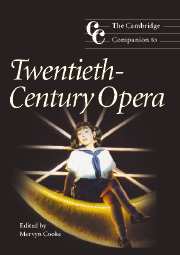Book contents
- Frontmatter
- Part one Legacies
- Part two Trends
- Part three Topographies
- 8 France and the Mediterranean
- 9 Austria and Germany, 1918–1960
- 10 Eastern Europe
- 11 Russian opera: between modernism and romanticism
- 12 American opera: innovation and tradition
- 13 Opera in England: taking the plunge
- Part four Directions
- General index
- Index of operas
12 - American opera: innovation and tradition
from Part three - Topographies
Published online by Cambridge University Press: 28 September 2011
- Frontmatter
- Part one Legacies
- Part two Trends
- Part three Topographies
- 8 France and the Mediterranean
- 9 Austria and Germany, 1918–1960
- 10 Eastern Europe
- 11 Russian opera: between modernism and romanticism
- 12 American opera: innovation and tradition
- 13 Opera in England: taking the plunge
- Part four Directions
- General index
- Index of operas
Summary
American opera of the twentieth century encompasses a great diversity of styles that vividly reflect the wide landscape of America's social and cultural life. In an opera world dominated by European tastes and traditions, American composers have reached out for their own individual voices. Some have turned to indigenous sources – Native American motifs, black culture, jazz forms, American literature or Hollywood cinematic effects. Others have found a voice in non-narrative ideology, preferring ritual to description, and symbol to an unfolding storyline. But whether in mellifluous melody, romantic-hued harmony or acerbic atonality, American composers melded music and drama within the vital framework of life around them. They saw their art as individual and American, but they also understood music's powerful role in defining character and propelling the drama forwards.
Belonging to a nation of explorers and rugged individualists of many ethnic origins and modes of thought, Americans wrote opera as they travelled along a historic road of many twists and turns. The eclecticism of this opera – its panorama of styles, subjects and moods that seem to know no boundaries – both reflects and defines its people. With the possible exception of Gian Carlo Menotti, who was especially influential in the 1940s and 1950s, there is essentially no enduring ‘school’ of American opera. Whether William Henry Fry or Walter Damrosch in the nineteenth century, or Virgil Thomson, George Gershwin, Philip Glass or Carlisle Floyd in the twentieth, each composer – each opera – is distinctive. And each offers an element of surprise along the path to discovery that lies at the heart of American opera.
- Type
- Chapter
- Information
- The Cambridge Companion to Twentieth-Century Opera , pp. 197 - 208Publisher: Cambridge University PressPrint publication year: 2005
- 1
- Cited by



